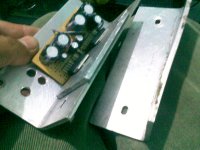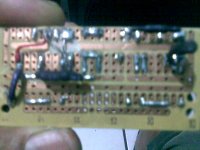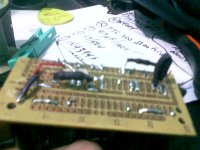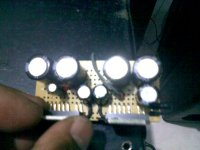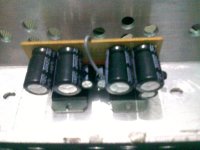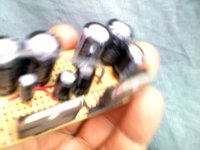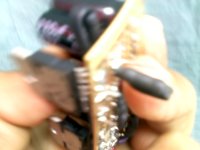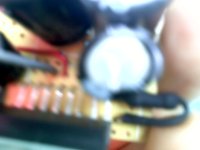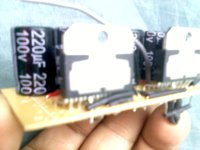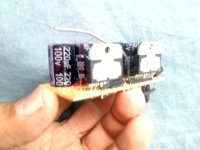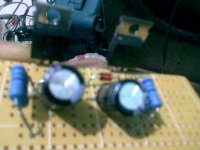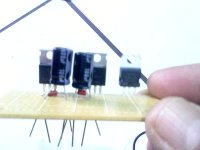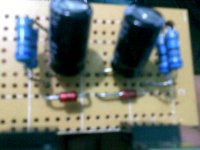Or simply use the same length of cable to each cap from the star. It pays to match.Sparks? That's construction error. The connections are a bit flimsy and voids are causing sparks, so you need MUCH THICKER traces (probably needs reinforced with wire and solid soldering).
Also, the pi filter resistors need to be paralleled with minimum pin length and not look like a fishing net.
I think I see a ground loop that might cause dulling, so that needs fixed. Hey, I've made a drawing for you.
The green traces have the conductor Thickest to Farthest caps.
i´ll wait to check this as is, and then add snubbers and
or smaller-bypassing-larger caps.
the one 220uf 63 that i had is for the fb-string,
should i bypass it with diodes?
and how doyou see the heatsink? what be better,
put the tabs directly onthe large Al piece?
or use the small plate first?
I´ll be using a fan fullspeed alltime, blowing into
the case and out at the other end.
Using both pieces to make U channel
or smaller-bypassing-larger caps.
the one 220uf 63 that i had is for the fb-string,
should i bypass it with diodes?
and how doyou see the heatsink? what be better,
put the tabs directly onthe large Al piece?
or use the small plate first?
I´ll be using a fan fullspeed alltime, blowing into
the case and out at the other end.
Using both pieces to make U channel
Last edited:
This is for double circuit, master-slave
to drive two 8 ohm speakerboxes
from fender passport 250.
Tbe used with a simple integrated
mic-line mixer, w builtin eq and efx
power derived from same psu.Need
to feed two +-12 V regs, and one
5V forthe efx module.
the mixer was brought burnt PS,
and no amp.
to drive two 8 ohm speakerboxes
from fender passport 250.
Tbe used with a simple integrated
mic-line mixer, w builtin eq and efx
power derived from same psu.Need
to feed two +-12 V regs, and one
5V forthe efx module.
the mixer was brought burnt PS,
and no amp.
That value NFB-Shunt-Cap is small enough that it doesn't need diode bypass; however, 220u is big enough that you might want a little bypass cap for treble helper.the one 220uf 63 that i had is for the fb-string, should i bypass it with diodes?
Well, I like it done normally. Watch out--those tabs have voltage!and how doyou see the heatsink? what be better, put the tabs directly onthe large Al piece? or use the small plate first? I´ll be using a fan fullspeed alltime, blowing into the case and out at the other end.
Shoulder washers on tabs, tabs to insulating layer, insulating layer to big aluminum stuff, make the amp run cool stable and efficient so you can throw the fan away.
Enclosure with air intake vent and air output vent, and without needing a fan the warm heatsink will cause hot air to exit at/near enclosure top if when cool air is allowed to enter at near enclosure bottom. . . so you put the heatsink into this nonstop voluntary fanless draft of air to cool it.
Yes, it will go a lot better if you did that. The TDA7295 is the go-to part for repairing an older TDA7294 production amplifier. When, in case, they're both the old "Singapore" labeled parts, there's no electronic difference. That part is likely to be what you'd expect.please, can tda7295 be used in place of tda7294?
second image in post #13 under
https://www.diyaudio.com/community/...ication-to-current-drive.389985/#post-7116498
show from my view the best solution for realizing a diy chip amplifier without PCB.
https://www.diyaudio.com/community/...ication-to-current-drive.389985/#post-7116498
show from my view the best solution for realizing a diy chip amplifier without PCB.
- Home
- Amplifiers
- Chip Amps
- Point 2 Point (no PCB) for TDA7293, TDA7294, TDA7295, TDA7296.
